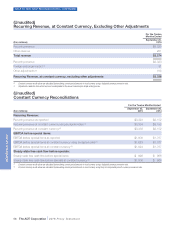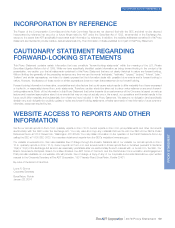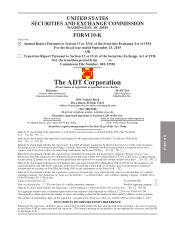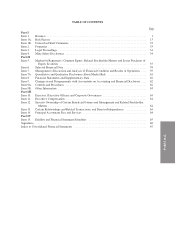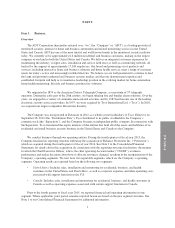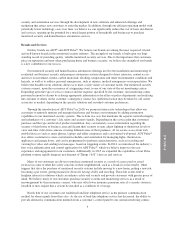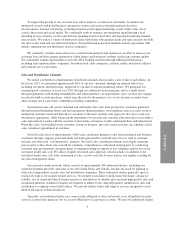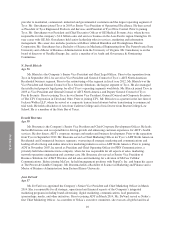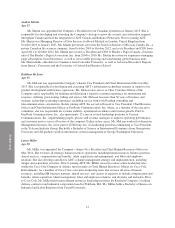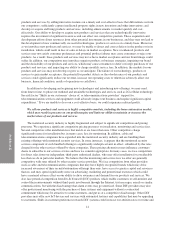ADT 2015 Annual Report Download - page 78
Download and view the complete annual report
Please find page 78 of the 2015 ADT annual report below. You can navigate through the pages in the report by either clicking on the pages listed below, or by using the keyword search tool below to find specific information within the annual report.
FORM 10-K
has become increasingly important. We currently offer, and recommend, a variety of alternate and back-up alarm
transmission methods including cellular and broadband Internet. See Risk Factors “Shifts in our customers’
choice of, or telecommunications providers’ support for, telecommunications services and equipment could
adversely impact our business and require significant capital expenditures.”
In our health business, we provide monitoring center supported personal emergency response system
(“PERS”) products and services which leverage our safety monitoring infrastructure to provide customers with
solutions that help sustain independent living, encourage better self-care activities and improve communication
of critical health information. Our core PERS offering consists of a wired or wireless console unit in premise and
a wireless transmitter generally worn as a necklace or wristband by the customer. In the event of an emergency,
the transmitter allows the customer to summon assistance via a two-way voice system that connects to our
emergency response center that is staffed with dedicated PERS monitoring specialists. The monitoring team
relays information to the appropriate local emergency responders, including Emergency Medical Services
(EMS), police and fire departments as well as family members. We offer PERS units for customers with and
without traditional telephone service. The majority of PERS units are shipped directly to the customer for easy
set-up, however if required, trained field support is available upon request. In 2015, we introduced a new solution
which is a mobile unit (“mPERS”) that provides the same capabilities as the in premise solution. Our monitoring
centers are capable of communicating with the mobile unit over a two-way voice intercom and can determine the
unit/user’s location using GPS technology. Additionally, we added fall detection capabilities to our wireless and
mobile solutions, which upon a customer fall, automatically alerts our monitoring centers.
In addition to monitoring services, we provide customer service for routine maintenance and the installation
of upgraded or additional equipment. A majority of our customer base is enrolled in a service plan which
provides additional value to the customer and generates incremental recurring monthly revenue for ADT.
Purchasers of our monitored security and home/business automation systems typically contract for ongoing
system monitoring and maintenance at the time of initial equipment installation.
Most of the monitoring services and a large portion of the maintenance services that we provide to our
customers are governed by multi-year contracts with automatic renewal provisions that provide us with recurring
monthly revenue. Under our typical service agreement, the customer pays an upfront fee and is then obligated to
make monthly payments for the remainder of the initial contract term. The standard agreement term is three years
(two years in California), with automatic renewals for successive 30-day periods unless canceled by either party.
If a customer cancels or is otherwise in default under the contract prior to the end of the initial contract term, we
have the right under the contract to receive a termination charge from the customer in an amount equal to a
percentage of all remaining monthly payments. Monitoring services are generally billed monthly or quarterly in
advance. More than half of our customers pay us through automated payment methods, with a significantly
higher percentage of new customers opting for these payment methods. We periodically adjust the standard
monthly monitoring rate charged to new and existing customers.
Customers and Marketing
We serve approximately 6.6 million residential and business customers throughout the United States and
Canada. Our residential customers are typically owners of single-family homes, while our business customers
include, among others, retail businesses, food and beverage service providers, medical offices and clinics,
mechanical and auto-body shops, professional service providers and small-scale commercial facilities. We
manage our existing customer base to maximize customer lifetime value, which includes continually evaluating
our product offerings, pricing and service strategies, managing our costs to provide service to customers,
upgrading existing customers to ADT Pulse®, and achieving long customer tenure. Our ability to increase
average revenue per customer is derived from, and largely dependent on, our continued introduction of additional
features and services that increase the value of our offerings to customers. Additionally, on September 29, 2014,
the non-competition and non-solicitation provisions associated with the Separation expired and, as a result, we
are no longer prohibited from competing in the commercial security market and therefore began expanding into
the mid-sized commercial market.
4


